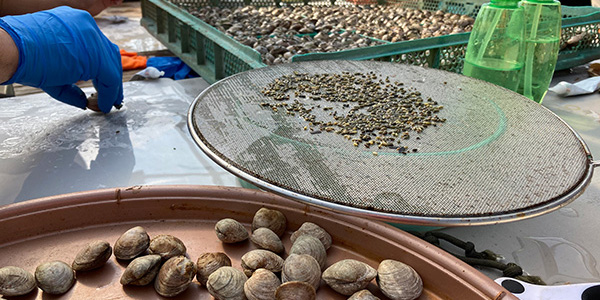
This is the second installment in a series of stories that will track the progress of our eelgrass restoration project, a collaboration featuring Save the Sound, SAVE Environmental, and the Cornell Cooperative Extension. The accompanying video is made possible by support from 11th Hour Racing.
At first glance, the setup looked less like a scientific work station than a crafts workshop.
Clear plastic sheets lay on opposite sides of the plywood tabletop like invisible placemats, see-through except in the many places streaked and smudged with residual glue. To either side sat square blue-green flatware racks. One held the blank canvas for this project, the other collected the finished product.
In the middle of the table, at the heart of it all, a circular screen rested atop a green bowl. Spread out on the screen, like a thousand spilled sprinkles, were tiny pellets of hope.
Eelgrass seeds.
Despite the low-tech appearance inside the greenhouse on the Cornell Cooperative Extension property beside Peconic Bay in Southold, NY, the stakes couldn’t have been higher. As the Saturday sun warmed the air outside and in, the action along this makeshift assembly line was heating up.
Emma DeLoughry, Soundkeeper associate, sat across from Ched Baker, a local volunteer from Orient Point. Over and over, they ran through the routine as it had been laid out to them: grab a live hatchery clam from the one rack, dry its shell with a hand towel, and drag the apex of the shell through a line of glue. Then, dip the freshly sticky surface into the eelgrass seeds, rocking the clam left and right until 10 or so seeds had been affixed, and deposit the sprinkled bivalve in the other rack.
It was slow, repetitive, tedious work – “Exactly what my brain is good for,” Ched joked. Eventually several racks would be filled, each with 500 or so inch-and-a-half living packages of possibility.
“What I came up with is what they call ‘biomimicry.’ It’s mimicking nature. That’s all we’re doing,” said Rob Vasiluth of SAVE Environmental, one of our project partners, along with CCE. “We’re forcing the clam to take seeds with it every time it buries itself.”
Biomimicry turned out to be Rob’s cipher to the code of bringing eelgrass back to parts of Long Island Sound where it once thrived. Harvesting the seeds has not been the problem for eelgrass restoration efforts; Rob and Emma collected more than 80,000 seeds over three dives in a flourishing eelgrass meadow off Fishers Island this summer. Successfully planting the bounty of seeds is another matter, and it wasn’t until Rob, an operating engineer by trade, viewed the challenge as a matter of mechanics that a potential solution clicked in his imagination.
“These seeds are negatively buoyant, so they sit on the sea floor. Every once in a while, a clam will bury itself, and a seed that falls in the hole will grow,” said Rob. “That’s the mechanical advantage we’re using with this animal. It’s doing its burying thing, and that’s exactly what we need.”
It is a notion as elegant as it is simple: gluing seeds to the shells of clams, who when deployed into the November-cold waters of Smithtown Bay will bury themselves in the Sound’s floor as quickly as possible. Ten eelgrass seeds will be implanted into the ground on each conveyor clam; if just 10% of those viable seeds takes root and grows, that would mean one new eelgrass plant per clam born into a new home. With 8,500 seed-carrying clams to be deposited in the waters off Sunken Meadow State Park, we could be looking at a true nature-based solution to the decades-long puzzle of bringing eelgrass back to this part of the Sound.
